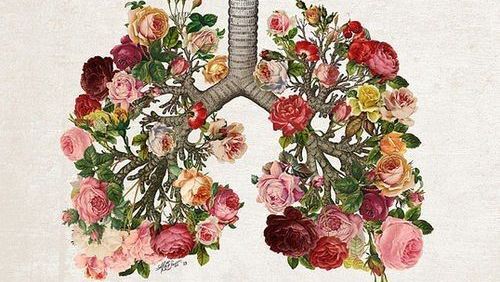
Breathe in, breathe out.
Breath – we cannot live without it. You never really think about breathing, you just ‘do it’. Yet most of the world’s population is not breathing fully. Breathing is a spontaneous function of the body, how can it be that not all bodies breathe fully?
What doesn’t help is “lazy” breathing muscles and too little physical activity. This creates far from optimal breathing in most people.
There is an intimate connection between life and your breath; they don’t exist without each other. You can go three days without water, a few weeks without food but without breath, you already have a serious problem after a few minutes.
The “Hatha Yoga Pradipika” mentions this about breathing: Life is the period between one breath and the next. A person who only breathes half only lives half. He who breathes correctly, acquires control of the whole being”.
No breath = no life. In yoga it is also said that you have a maximum number of breaths at your disposal. If you can slow the breath down, you’ll live longer. There is a great truth in it; A quick breath is associated with tension, anxiety, and worry, leading to tension of your nervous system. This leads to poorer health, unhappiness and a shorter life than someone who breathes fully.
Someone who takes the time to breathe slowly is relaxed, calm and happy, due to the positive effect on the nervous system – which contributes to a longer life span
 If you breathe quickly, you inhale small volumes, allowing (disease) germs to nest in the lower half of your lungs. Also ‘stale air’, old air that is already used, remains at the bottom of your lungs, if you do not fully inhale and exhale. Starting your day with some hearty inhalations and exhalations will help you avoid this and make you feel more energetic! It feels like you’re throwing open your windows in the spring after a long winter, to let out the stale air and invite the fresh air in!
If you breathe quickly, you inhale small volumes, allowing (disease) germs to nest in the lower half of your lungs. Also ‘stale air’, old air that is already used, remains at the bottom of your lungs, if you do not fully inhale and exhale. Starting your day with some hearty inhalations and exhalations will help you avoid this and make you feel more energetic! It feels like you’re throwing open your windows in the spring after a long winter, to let out the stale air and invite the fresh air in!
If you breathe slowly, you also breathe deeper. A deeper breath that fills the lungs all the way down, also gives a massage to the abdominal organs. If you also would add a twist, you also wringe the mustiness out of your organs… which is why you have to drink a lot after a yoga class, to make sure that everything you’ve cleaned up in your organs and lungs and got into your bloodstream can flush out.
Shallow breathing also leads to oxygen deficiency in your body. This indicates disturbances and imbalance in your blood circulation, digestion and nervous system. Everything in your body depends on oxygen to survive. An active lifestyle requires a certain efficiency of the lungs – especially when a lot is asked of your body. Thousands of years ago, we were still breathing. But these days? We live in a city with polluted air, move by car, sit most of the time, and most of the time we’re in a building, breathing old air, or breathing air coming from the air conditioning, or heated air.
Emotions also have a negative impact on your breath. If you try to suppress your emotions, you do so by stopping your breathing… It’s true that you’re going to feel a lot more when you start breathing freely!
If you just breathe, you breathe in and out about half a liter. It’s called tidal volume.
If you breathe in completely (in a comfortable way), you can add about 2 liters, on top of that 1/2 liter. It’s called your “inspiratory reserve volume”.
If you exhale as much as comfortable as possible after a natural exhalation (of half a liter), you will exhale another one and a half liters. It’s called your expiratory reserve volume.
There will always be air in your lungs, even after the deepest exhalation. It is about one and a half liters that always resides in your chest; Because your chest keeps your lungs open, because you don’t want your lung walls to stick together. It’s called residual volume.
If you compare your normal and your maximum breathing capacity (1/2 liter tidal, 2-liter inspiratory reserve, 1 1/2 expiratory)you come to four liters.
That’s eight times more than your normal breath volume! And when you sit, you breathe less than that half-liter, and when you’re tense, you only get to a quarter of a liter. Can you imagine how energetic you can feel if you were to breathe fully?
To get started with this, you can simply practice this at home. Start breathing at a maximum of ten laps, at a very slow pace. This also increases your body’s ability to optimize the exchange of carbon monoxide and oxygen. If you add a few breaths every week until you fully breathe for about 10 minutes a day, it will for sure positively influence your health!
We think it’s wise not to give breathing lessons at this moment in time, but that doesn’t prevent us from putting an online breath lesson on the program: on Tuesday night at 20.30 you can attend a real Breathwork session with Carla Aspesberger online! Book your spot through the class schedule.
Information about breathing from “A systematic course in the Ancient Tantric Techniques of Yoga and Kriya “by Swami Satyananda Saraswati.


